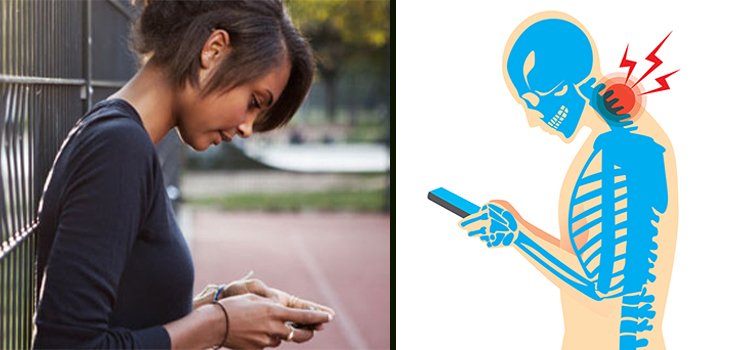“Text Neck” is Giving Young People Major Spine Issues

No matter where you go, you probably see people leaning over looking at their cellphones. Chances are, you’ve seen it in your own house. Hey, you might even do it yourself. (It’s OK, I won’t judge you – I do it, too.) Well, a study in The Spine Journal shows that young people who shouldn’t have back and neck problems are already reporting disc hernias and alignment complications due to prolonged smartphone use. [1]
X-rays reveal how young people’s spines are changing because of chronic smartphone use, researcher Todd Lanman, a spinal neurosurgeon at Cedars-Sinai Medical Center in Los Angeles, says. [2]
“In an X-ray, the neck typically curves backward, and what we’re seeing is that the curve is being reversed as people look down at their phones for hours each day.
By the time patients get to me, they’re already in bad pain and have disc issues. The real concern is that we don’t know what this means down the road for kids today who use phones all day.”
Lanman and study co-author Dr. Jason Cuellar, an orthopedic spine surgeon at Cedars-Sinai, say that people tend to look down at their phones more while texting than they do when they’re browsing the Internet or watching a video. Many young people rely on texting as their sole means of communication, which means they crane their necks often for several hours a day.
In earlier studies, researchers found that people hold their necks at about 45 degrees, and the curve gets worse as they sit, versus standing.
The weight of your head changes, depending on what position you’re in – something you might have noticed but never actually connected with your neck and back problems. When you’re looking forward in a neutral position, your head weighs about 10-12 pounds. However, at a 15-degree flex, it feels like 27 pounds. The stress on the spine increases by degree, and at 60 degrees, it’s 60 pounds. That’s one heavy noggin.

Lanman says:
“For today’s users, will an 8-year-old need surgery at age 28? In kids who have spines that are still growing and not developed, we’re not sure what to expect or if this could change normal anatomies.”
These Problems are Easily Avoided
Fortunately, you can avoid developing such problems by simply “training” yourself to hold your phone in front of your face or near eye level while texting. You may also find that you’re more comfortable if you use 2 hands and both thumbs to make your spine more symmetrical. [1]
Poor posture and spine problems also affect people who regularly use computers and tablets. If that’s you (it’s certainly me), the researchers recommend using an elevated monitor stand so your computer or tablet sits at a natural horizontal eye level. [2]
If you’re a laptop user, you can alleviate the problem by using a separate keyboard and mouse so that the laptop can be at eye level and you can sit in an ergonomically-correct position.
Gwanseob Shin of the Ulsan National Institute of Science and Technology Ergonomics Lab in South Korea, who wasn’t involved with the study, says:
“It is difficult to recommend a proper posture for smartphone users. If we raise the phone at eye level to avoid the look-down posture, it will add new concerns for the shoulder due to the elevated arm posture.”

Instead, Shin says, smartphone users should take “frequent rest breaks or some physical exercise that can strengthen the neck and shoulder muscles.”
Some of the stretches and exercises Lanman recommends involve lying on your bed and hanging your head over the edge while extending your neck backward, thus restoring the normal arc in your neck.
He also recommends aligning the neck and spine by making sure that your ears are over your shoulders, and your shoulders are over your hips.
Shin says:
“Ask your friend to take a photo of your upper body when you’re texting, then use the picture as the background image on your phone. That will remind you to take breaks frequently. Even a short break of a few seconds – called a micro-break – can help our tissues recover.”
Sources:
[2] Reuters
